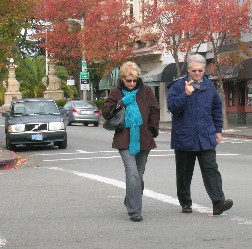By Cecily O’Connor, RedwoodAge.com
As life spans lengthen, cities are trying to be all things to all age groups. But they’re just scratching the surface.
Committees, studies and action plans are baby steps on a long road toward coordinating services and resources before a crisis sets in. The down U.S. economy is adding to the mess.
If you took a tour of Northern California, you’d see a microcosm of what’s happening elsewhere. Big cities like Sacramento are better prepared, thanks, in part, to a downtown ripe for redevelopment. Others like San Rafael, the county seat of the nation’s richest county, are watching new housing proposals dry up as the economy contracts. And not one city has figured out how services for different age groups can complement one another.
 |
| The "Complete Streets" program helps pedestrians, cyclists, and cars share city streets. (RedwoodAge.com) |
Planning prudently now can mean the difference between a highly livable multigenerational city that succeeds, or bankrupt communities struggling with poverty and street crime.
Dozens of interviews with officials, activists and residents in five Northern California cities showed that communities that choose to become age-friendly now are positioning themselves for further growth as 78 million baby boomers move into their retirement years over the next two decades.
Three main concerns — housing, transportation and health services — are equally pressing, and in many ways, go hand in hand.
Sacramento is one city that recognizes this. A big part of its long-term general plan centers on downtown development. It plans to make the city walk and bike friendly, to build housing in areas like the old rail yard, to emphasize cultural amenities, and to expand the existing light-rail system.
The "goal is to create a 24-hour destination where there are people who live and work downtown, so streets are enlivened by residents in the nighttime, not just workers in the daytime," said Tom Pace, long-range planning manager. "That will make downtown safer and appeal to a certain segment of the older population."
By comparison, Santa Rosa has much more planning ahead. Culturally speaking, it’s hard to beat. It’s nestled in the wine country and offers a charming downtown full of restaurants, making Santa Rosa attractive to both young and old. City officials are crafting goals to keep it that way.
"Now is the time to start," said Shirlee Zane, chief executive officer of the local Council on Aging. Zane, recently elected to Sonoma County’s board of supervisors, created a mayor’s advisory committee several years ago to improve issues for seniors and the disabled.
Limited bus service, with routes that run until 8 p.m., is one improvement area, Zane said. "If you’re a senior and want to go to a movie or public meeting, you’re limited on the bus routes," Zane said. "That’s an example of ways we need to start looking forward for how we’ll meet the needs of our aging population."
Healthcare is another, although cities like Santa Rosa have a somewhat limited role because health is largely a county service. But local officials are mindful of the fact that affordability and access is a major issue residents of all ages face.
"Unless you belong to Kaiser, (it’s) really a problem to have access to specialists in Sonoma County," said Zane, noting its Medicare physicians are reimbursed at a lesser rate than doctors in neighboring counties because Sonoma County is considered "rural." The federal government believes things cost less in rural areas, even when it’s the nation’s premier wine region.
‘We Can Always Do More’
To the south, Marin County, the grayest and richest of all counties in California, recently took a step in the right direction by opening a health and wellness center in San Rafael. It situated the campus near a community center and school.
Still, San Rafael faces broad problems, many of which are mirrored in a recent report on the county. Due to a rapidly aging population, Marin needs to address shortages of in-home support services, cheaper health care, affordable housing and transportation, according to the nonprofit Marin Community Foundation. An action plan by the foundation and civic leaders is in the works to fill those gaps.
"I think we’re doing pretty well," said Linda Jackson said, principal planner in San Rafael’s Community Development Department. "We can always do more, though. Looking ahead, I do worry about housing and accessibility…"
Older residents know first-hand where cracks in service are surfacing. That includes certain areas of San Rafael that aren’t near public bus routes, said Olivia Schultz, who lives in the Peacock Gap neighborhood. "We did have service, and no one took it," she said. "But we were all young then."
San Francisco also wrestles with the "age-friendliness" of its neighborhoods, said Ann Hinton, director of the Department of Aging and Adult Services. It’s tricky due to the city’s hilly composition, which results in stairs and tough access.
"We may have more services like transportation, but then you have issues of, ‘How do you get in and out?’" Hinton said. Stair lifts is one solution worth exploring, she said.
Huge potential
San Rafael also is encouraging new design features that help residents age in place. One idea is second units that can be added to single-family home properties to lodge downsizing boomers, or a caregiver.
"When you think that we have around 9,000 single family homes in San Rafael that would qualify under our rules, there’s huge potential," said Jackson, noting the city has conducted educational workshops over the past three years, and collaborated with other agencies to lower fees and ease the permit process.
At the same time, San Rafael could benefit from more affordable housing downtown. However, the city relies on private development, and proposals aren’t being made because builders are having a tough time securing financing.
San Rafael also supports the idea of co-housing, in which residents own their own homes and benefit from shared land, workshop areas and a community room for eating meals. But the high cost — and scarcity — of land is a challenge. "In Marin and in San Rafael, there’s little vacant land left," Jackson said.
Of course, co-housing developments don’t have to be created from scratch. Many have formed organically in long-standing neighborhoods made up of condos or single-family homes. That includes one in Davis, Calif., about 11 miles west of Sacramento, and another in Berkeley, just across the Bay from San Rafael.
Boomers’ interest in these types of alternatives continues to build as people look to create stronger communities and deal with increasing economic pressures on cities and their residents.
‘Very Challenged’
Of all the cities on our tour, Vallejo residents face the most financial fallout, in the form of decreased service. That’s because the city is weighted by a $16 million deficit and declared bankruptcy last spring.
Vallejo "is very challenged to provide a basic level of services to our entire community," said Craig Whittom, assistant city manager. "Our current effort is to emerge from bankruptcy in a manner where we have a breadth of service that provide basic municipal services (fire protection, police) to the community."
Whittom said it’s uncertain how quickly Vallejo will be able to build upon the basic services. For example, he said he’s "not optimistic" Vallejo can fund the senior center "at a level that we would like to." The city owns the Vallejo Senior Center facilities and leases it to a nonprofit that administers programs there.
Yet before Vallejo’s financial fiasco, housing was one area it had built up over the past 15 years, creating three affordable senior developments, Whittom said. Another high-end project called Belvedere is about three-quarters built. It was intended as a gated community for adults over 55, but that age restriction is being revisited to create a multi-family project, and eventually, sell more units.
San Francisco has worked on aging for a long time, but it faces big budget shortfalls. Yet long-term care is one area in need of funding, according to a proposal by the Long Term Care Coordinating Council (LTCCC). That proposal seeks to improve and expand the city’s network of home, community-based and institutional long-term care services between 2009 and 2013.
With one in eight boomers expected to develop Alzheimer’s, dementia is another public health issue in the spotlight. San Francisco is forming a task force that will recommend dementia care strategies and services in 2009, Hinton said, but so far, there’s no real plan.
Overall, the intentions of task forces in San Francisco and other cities are all good, but their ability to develop and carry out plans will depend upon coordinated efforts by city agencies and other groups – many of whom are often competing for the same grant dollars.
"The idea would be to find common program development areas and eliminate the geographic, this-is-my-territory mentality," said Robert Trevorrow, executive director at the San Francisco Senior Center, and a LTCCC member.
Residents also bear responsibility in the creation and sustainability of age-friendly communities. They can not only call attention to problems, but lend a hand in crafting solutions.
Read the Entire Series
- Main Article
- Part 1: A Gray Wave Hits Home
- Part 3: Neighbors Saving Neighborhoods
- Hear reporter Cecily O’Connor interviewed on KALW Radio (1/26/09)
Cecily O’Connor is a senior writer for RedwoodAge.com, a news site for readers over 40. This report was produced by RedwoodAge with financial support from the community-funded journalism site Spot.us.










